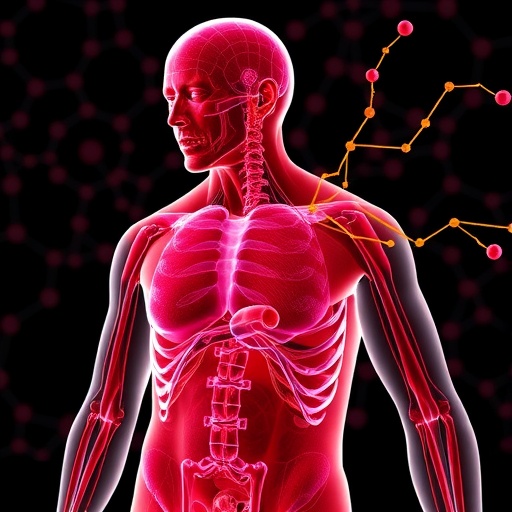The debilitating muscle wasting frequently observed in cancer patients, clinically recognized as cancer cachexia, remains a formidable challenge in oncology due to its complex biology and poor therapeutic options. Despite its clear association with adverse clinical outcomes—including diminished quality of life and reduced survival—the molecular underpinnings of muscle loss in cancer have largely eluded comprehensive characterization in humans. Now, a breakthrough study published in Nature leverages state-of-the-art transcriptomic technologies coupled with advanced computational methods to unravel distinct molecular subtypes in skeletal muscle from cancer patients, illuminating the intricacies of cachexia at an unprecedented depth.
In a groundbreaking investigation, researchers undertook an unbiased, integrative analysis of the full RNA landscape—or RNAome—encompassing both coding and non-coding RNAs extracted from skeletal muscle biopsies of patients afflicted with colorectal or pancreatic cancer. The rectus abdominis muscle, favored for its accessibility and clinical relevance, served as the tissue of choice. High-throughput next-generation sequencing generated vast data sets enabling a holistic view of transcriptomic alterations in diseased muscle tissue. To delve deep into the biological heterogeneity, the team applied integrative non-negative matrix factorization (iNMF), a powerful unsupervised clustering algorithm designed to dissect complex multi-modal data into coherent subgroups without preconceived hypotheses.
The application of iNMF revealed the existence of two distinct molecular subtypes within the skeletal muscle of cancer patients. These subtypes exhibited significant divergence not only at the molecular level but also in clinical phenotype, with patients assigned to subtype 1 epitomizing the cachectic condition. Clinically, this group was marked by severe weight loss, diminished muscle mass, selective atrophy of fast-twitch muscle fibers—specifically type IIA and type IIX—and consequentially, worse survival outcomes compared to subtype 2. This bipartite molecular classification provides a meaningful framework by which to understand the spectrum of muscle wasting in cancer beyond classical clinical observations.
Delving into the molecular differences driving these subtypes, the study identified distinct biological pathways that likely orchestrate the muscle catabolism observed in cachexia. Notably, disruptions in posttranscriptional regulation emerged as a critical axis, implicating the complex regulatory interplay between non-coding RNAs—such as microRNAs and long non-coding RNAs (lncRNAs)—and messenger RNAs (mRNAs). Such findings underscore that muscle wasting in cancer is not solely a consequence of gene expression changes but also involves nuanced control at the RNA level, suggesting sophisticated layers of regulatory dysfunction.
Another key aspect of the cachexia-associated molecular profile was the perturbation of neuronal systems within skeletal muscle. This neuronal involvement hints at compromised neuromuscular junction integrity or altered muscle innervation, aligning with emerging evidence that neuronal health is vital for maintaining muscle function and mass. Together with altered immune signaling pathways—namely increased cytokine storm and cellular immune responses—these observations suggest an inflammatory and neuroimmune milieu contributing to muscle degradation.
The extracellular matrix (ECM) pathways were similarly disrupted between the two muscle subtypes. As the ECM provides the structural scaffold for muscle fibers and is instrumental in cell signaling, its dysregulation could exacerbate muscle weakness and architectural remodeling in cachexia. These ECM alterations may reflect fibrosis or other pathological changes compromising muscle tissue integrity, further impairing function.
Metabolic aberrations stood out as a hallmark of the cachexia subtype. A spectrum of metabolic pathways, including xenobiotic metabolism, haemostasis, signal transduction, and amino acid metabolism, displayed significant dysregulation. Particularly fascinating was the involvement of pathways linked to embryonic and pluripotent stem cell states, suggesting a reversion or disruption of muscle cellular identity and regeneration capacity. This metabolic rewiring likely contributes to muscle atrophy and impaired recovery, highlighting potential metabolic vulnerabilities amenable to future intervention.
The discovery of these intertwined, higher-order gene regulatory networks paints a complex picture of cancer cachexia, emphasizing that muscle wasting emerges from the convergence of multiple molecular signals rather than isolated perturbations. Within this regulatory web, certain lncRNAs and microRNAs appear to act as hubs—critical nodes that integrate various signaling streams. These hub non-coding RNAs represent compelling targets for mechanistic studies and therapeutic exploration, as modulating their activity could recalibrate the pathological gene expression landscape driving cachexia.
Importantly, the study demonstrates the power of combining advanced sequencing technology with robust computational frameworks like iNMF to deconvolute heterogenous clinical samples. By moving beyond traditional linear analyses and embracing integrative, network-based approaches, researchers can now identify biologically meaningful muscle subtypes that correlate with clinical outcomes. This stratification lays the groundwork for personalized therapeutic strategies tailored to the molecular phenotype of cachexia in individual patients.
The clinical ramifications of distinguishing molecular subtypes within cancer-associated muscle wasting are profound. Current cachexia management remains largely supportive, lacking targeted treatments. The elucidation of specific pathways and gene networks offers a roadmap for the development of novel interventions—whether they be small molecules, RNA-based therapeutics, or biologics—that can mitigate or reverse muscle loss. Furthermore, molecular subtype classification might inform prognostic assessments and guide clinical decision-making in oncology.
This pioneering research also invites broader questions about the crosstalk between tumor biology and systemic tissue remodeling. How tumor-derived factors orchestrate these complex muscle responses, and whether similar molecular subtypes exist across other cancer types or comorbid conditions involving muscle wasting, remain to be explored. Such insights could ultimately reshape our understanding of cancer as a multi-organ disease with far-reaching systemic effects.
In conclusion, the identification of discrete molecular subtypes in the skeletal muscle of cancer patients marks a significant milestone in the quest to demystify cancer cachexia. By illuminating the underlying regulatory networks and biological processes involved in muscle wasting, this study propels the field toward mechanistic clarity and therapeutic innovation. As the landscape of cancer treatment evolves, integrating molecular subtyping of cachexia may enhance patient care and improve survival outcomes—offering renewed hope for those afflicted by this debilitating syndrome.
Subject of Research: Molecular subtypes of human skeletal muscle in cancer cachexia.
Article Title: Molecular subtypes of human skeletal muscle in cancer cachexia.
Article References:
Bhatt, B.J., Ghosh, S., Mazurak, V. et al. Molecular subtypes of human skeletal muscle in cancer cachexia. Nature (2025). https://doi.org/10.1038/s41586-025-09502-0
Image Credits: AI Generated




